Congratulations to downunderpix’s Paul Macdonald & Elizabeth Solich on having the little rod-less anglerfish that they have been finding at Edithburgh confirmed as being a new species that has been given the name Narungga Frogfish, Histiophryne narungga. It was previously thought to have been the cryptic or rodless anglerfish, Histiophryne cryptacanthus.
Some of downunderpix’s photos of the Narungga Frogfish can be viewed at Edithburgh – downunderpix.. You will also see some more photos if you scroll down downunderpix’s Facebook page.
According to Wikipedia, “The cryptic anglerfish (Histiophryne cryptacanthus) is a frogfish found in waters ranging from Taiwan to South Australia. There are an estimated 75 specimens known. The luring appendage on its forehead is reduced to nearly nothing.”
According to iNaturalist, the little rod-less anglerfishes species found on the Yorke Peninsula is now known not to be Histiophryne cryptacanthus, and was taxonomically described as the Narungga Frogfish, Histiophryne narungga recently at University of Washington.
According to Fishes of Australia , Histiophryne narungga (CAAB Code 37210013) was named by RJ Arnold & TW Pietch in 2018. Rudie Kuiter took 3 photos of the Narungga Frogfish at Edithburgh jetty in 1984. More information, references and classification can also be found.
According to Wikipedia, “The cryptic anglerfish (Histiophryne cryptacanthus) is a frogfish found in waters ranging from Taiwan to South Australia. There are an estimated 75 specimens known. The luring appendage on its forehead is reduced to nearly nothing.”
According to iNaturalist, the little rod-less anglerfishes species found on the Yorke Peninsula is now known not to be Histiophryne cryptacanthus, and was taxonomically described as the Narungga Frogfish, Histiophryne narungga.
There are no reported sightings of the cryptic (or rodless) anglerfish, Histiophryne cryptacanthus on iNaturalist. There have been just two sightings of the Narungga Frogfish, Histiophryne narungga reported, both from Edithburgh. One sighting was in December 2006 (3 photos), whilst the other sighting was in December 2018 (1 photo).
Ron Greer has generously allowed us to use his iNaturalist photos from 2006 here: –
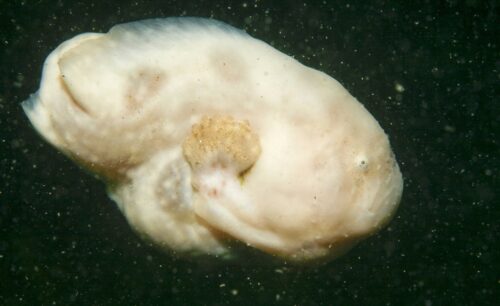
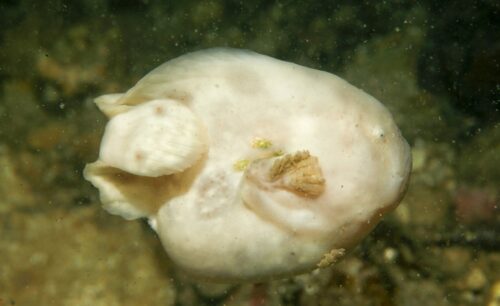
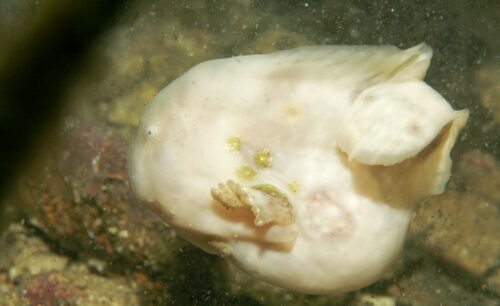
All photos taken by Ron Greer at Edithburgh jetty in 2006
(Taken from iNaturalist at Narungga Frogfish (Histiophryne narungga) from Edithburgh SA 5583, Australia on December 21, 2006 at 01:18 PM by ronigreer · iNaturalist Australia (ala.org.au))
According to the web page found at https://novataxa.blogspot.com/2018/11/histiophryne-narungga.html , the Narungga Frogfish, Histiophryne narungga is “An undescribed species of the frogfish genus Histiophryne, of the teleost order Lophiiformes, family Antennariidae, is described on the basis of 60 specimens collected from shallow inshore waters of Western and South Australia. Previously confused with its morphologically similar congener H. cryptacanthus, it differs from the latter and from all other members of the genus in having the following combination of features: illicium tiny but easily discernible without aid of a microscope; esca present, a small tuft of filaments, easily distinguished from illicium; skin covered with tiny dermal spinules, especially on head, cutaneous filaments and appendages absent; dorsal-fin rays 15–16; pectoral-fin rays 9 (rarely 8); vertebrae 22–23; head, body, and fins typically off white, sometimes peppered with numerous small, close-set ocelli. Genetic divergence from its congeners in the nuclear recombination activation gene-2 (RAG2) and cytochrome oxidase-I (COI) genes is at least 8.9%. The new species is diagnosed, described, and compared with its congeners. A revised key to the species of the genus is also provided.
The scientific paper describing the Narungga Frogfish is titled “Fantastic Beasts and Where to Find Them: A New Species of the Frogfish Genus Histiophryne Gill (Lophiiformes: Antennariidae: Histiophryninae) from Western and South Australia, with a Revised Key to Congeners” by Copeia Arnold, R.J. and Pietsch, T.W. 2018. 106, No. 4, 2018, 622–631. DOI: 10.1643/CI-18-112.
According to the web page found at https://reefs.com/2018/10/31/histiophryne-narungga-a-cute-new-frogfish-from-south-australia/ , “the Narungga Frogfish is the latest addition to the bizarre and fascinating genus Histiophryne. It comes from the temperate reefs of South Australia, whose benthic ecosystems are dominated by large, colorful sponges. Seen against this backdrop, the lumpy, white body of this little frogfish virtually disappears into the sea floor.
“Histiophryne narungga might be newly described, but it’s by no means newly discovered. The species had previously been confused with a superficially similar member of this genus from the Coral Triangle, the Cryptic Frogfish (H. cryptacanthus). Both of these species feature a white body covered in small spots, but several subtle morphological differences—fin counts, vertebral count, illium/esca length—serve to distinguish the two, and this is supported further by a sizable genetic distance. Really, the biogeography and ecology of these fishes alone should have made it obvious, as the fish fauna from the tropical reefs of the Coral Triangle and the temperate fauna of South Australia are essentially non-overlapping.
Anita Futterer has generously allowed us to to use her iNaturalist photo from 2018 here: –
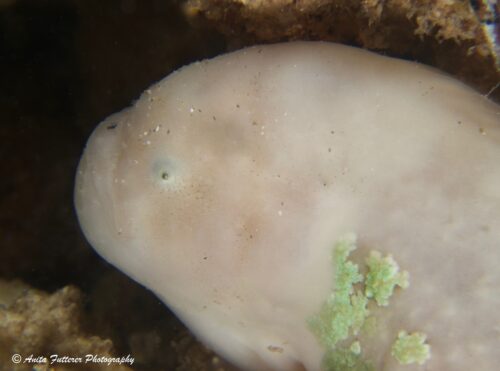
Photo taken by Anita Futterer at Edithburgh jetty in 2018
“While this new species is known from a broad swath of Australia’s coastline, in depths from 3–130 meters, it has been photographed most often at the Edithburgh Jetty and is named after an indigenous Australian tribe whose lands encompass this region. Further east, the closely related Queensland Frogfish (H. maggiewalker) and Smooth Frogfish (H. bougainvilli) can be found in the subtropical waters of Queensland and New South Wales, respectively.
“Histiophryne are remarkable creatures with a reproductive strategy that is quite unlike most marine fishes. Their eggs are unusually large (3-4 mm) and are closely guarded by the females, which protect them by creating a pocket formed against their curled body and fins… a marsupial fish of sorts. Instead of the typical pelagic larval stage, the juveniles hatch out as a miniature version of the adults and set about scrambling across the bottom in search of prey.
“As is often the case with marine fishes that have foregone a pelagic life history, these frogfishes are poor at dispersing themselves and are prone to speciating allopatrically. This is presumably how Australia wound up with its trio of endemic taxa in the south. And this also has some ramifications for how we understand the populations found in the Coral Triangle. In 2009, a sensational new species, the Psychedelic Frogfish (H. psychedelica), made headlines when it was described from Ambon, and, to date, this is still the only location where it has been encountered. But head a bit east to the Raja Ampat Islands of West Papua and you’ll encounter what appears to be another narrowly distributed (and still unstudied) species, the Honeycomb Frogfish.
“Small geographic ranges are probably common among these fishes. With more study, we may ultimately determine that the widespread Histiophryne of the Coral Triangle are really more like species complexes, with an evolutionary history defined by their unorthodox reproductive strategy. These small, isolated populations are naturally at an increased risk of being endangered from habitat destruction or aquarium collection. While generally uncommon in captivity, specimens of several species have been exported from across Indonesia, but the ease with which these can be captively bred offers hope for a sustainable future. It’s noteworthy that these adorable little frogfishes are reported to be quite friendly among themselves and their congeners, with up to a dozen having been kept together without resorting to cannibalism.”
(Header photo taken by Ron Greer at Edithburgh jetty in 2006)
STOP PRESS: It now turns out that Anita Futterer had also found a Narungga Frogfish at Edithburgh jetty in December 2017: –
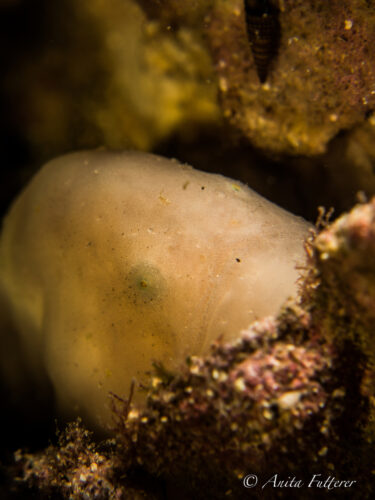
Photo taken by Anita Futterer at Edithburgh jetty in 2017
This means that each of the sightings posted to iNaturalist were made in December!

